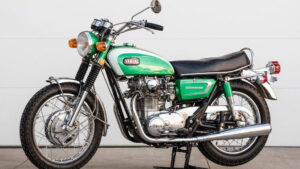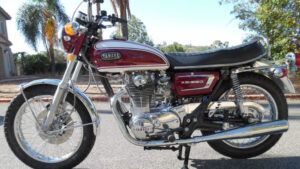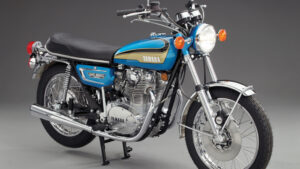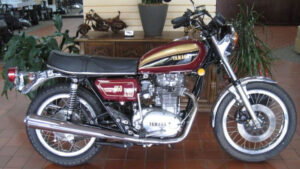1970-71 Yamaha XS1 & XS1B
Read MoreYamaha XS650 Model History
The Yamaha XS650 was Yamahas first four stroke motorcycle and ever since its introduction more than fifty years ago it has had a large and loyal fan base. The very fact that there are clubs and organisations around the world dedicated to the model after 50 years is a testament to the popularity of the motorcycle and you can still buy brand new parts and accessories for them.
Yamaha XS650 Owners Survey
Original article appeared in CYCLE WORLD magazine in June 1980
“You remember motorcycles. They have a pulsating throb instead of an electric motor whir …. They’re narrower than your car …. You can actually adjust the valves without removing the camshaft. Just one camshaft? …. gas tanks with curves instead of bends …. a strange looking lever on the side you can kick to make it run …. something you’d feel uncomfortable wearing a suit and tie on …. They let you park it with the Harleys down at the tavern.”
Sounds like a motorcycle, all right, but would you want to own one? Two hundred nine owners (70 percent with new machines) helped us answer that question. They cover the whole range of motorcyclists, from first-time bike owners to one old hand who started riding in 1928 and “used to ride with Dick O’Brien and Grover Sassaman in St. Pete, Florida 40 years ago.”
Collectively, they’ve put over 2.2 million miles on their Yamahas, some doing up to 40,000 miles per year, with an average yearly mileage of 6,200, the lowest yet on our surveys. Total mileage on the new bikes ranges from 500 to 70,000 miles. averaging 11,600. The used bikes average 8,200 miles for an overall average mileage of 10,600, a slightly higher figure than for the Yamaha 750 Triple (9,550 mi).
Pleasure riding accounts for many of those miles, with 87 percent of the owners riding their 650s for fun, a percentage exceeded only by Suzuki GS750 owners (89 percent). Nearly as many (84 percent) commute on their Yamahas, while the lowest percentage of riders in any of our surveys (47 percent) use their bikes for touring.
Despite the low number of tourers, only the Honda GL1000 owners have a gentler riding style. By category, the percentages are: very hard (5 percent), moderately hard (40 percent), average (49 percent) and gentler than average (6 percent). The combination of easy riding and the fuel-efficient vertical Twin returns the best fuel economy of the bikes we’ve surveyed – 48.5 mpg. Some riders reported figures as low as 35 mpg and as high as 70, with quite a few reporting consistent highway mileages in the 60s.
For most owners, the gentle riding style is accompanied by a willingness to leave the bike in original condition. Fifty-seven percent have stock machines and there are only three modifications listed by 5 percent or more of the owners. Thirteen percent installed headers or modified the exhaust system and 5 percent each installed electronic ignition or softer grips. In addition, 4 percent each modified the forks or changed the carb jetting and 3 percent each installed automotive coils or larger tires.
Accessories added by the Yamaha owners mostly fall into the comfort and convenience category. Luggage racks (41 percent) are the most common, followed by fairings and windshields (35 percent), backrests (27 percent), sissybars and crashbars (25 percent each), custom seats (18 percent), handlebars (16 percent), highway pegs (14 percent), shocks (12 percent) and quartz-halogen headlights (10 percent). Also added were oil coolers (7 percent), cruise control and horns (6 percent each) and air filters and extra mirrors (5 percent each).
The best accessories. followed by the number of attaboys received from the 650 owners are: various Yamaha accessories (12), Vetter fairings (11), Lockhart oil coolers (5), K&N air filters (5), Michelin tires (5), Drag Specialties sissybar and pad (4), Silhouette fairings (4) and Amco racks and backrests (4). In addition, Martek electronic ignition systems, Eclipse tank bags, Bosch QI headlights, Boge shocks, Vanda-Cruise and Yamaha Special seats were each praised by three riders. None of the products added were called unsatisfactory by more than one rider.
Easy maintenance is one of the attractions of a two-cylinder bike and the Yamaha 650 is no exception. As with the BMWs, none of the riders surveyed called the maintenance difficult, but not as many (62 vs 85 percent) said the maintenance is very easy. Thirty-eight percent found the Yamaha average to work on.
Even though the owners don’t find the Yamaha quite as simple to service as the BMW’s, more of the Yamaha owners do their own service. Eighty percent do all (45 percent) or most (35 percent) of their own work. Eighteen percent sometimes work on their machines and 2 percent always leave it to the mechanics. As one rider said, the Yamaha 650 is “the absolute easiest bike to own and maintain even if you have five thumbs on each hand.”
The 650 owners encounter few maintenance problems with their bikes and 59 percent say they have no problems. The only areas listed by 5 percent or more of the owners are: frequent chain adjustment or difficult chain removal (7 percent), worn-out alternator brushes (5 percent) and vibration-induced problems such as cracked brackets or loosened bolts (5 per cent). Also, 4 percent had trouble setting the ignition timing. “No electronic ignition. Imagine that in this day of four-door motorcycles.”
Many of the 650s require no “other than routine maintenance” and most of the repairs needed by the other bikes are related to a single problem-the alternator brushes. Ten percent had problems with the brushes, 9 percent had miscellaneous electrical problems and 5 percent had to replace the battery. Other problems include assorted oil leaks (6 percent), head-light failures (4 percent) and bad shocks (4 percent).
Reliability? The numbers say no but the owners say yes. Sixteen percent of the Yamaha 650s broke down or stranded their owners. making the 650 the least reliable bike we’ve surveyed. Or is it?
The most common breakdown reason (14 breakdowns), was worn out alternator brushes, at mileages from 6,000 to 17,000 miles. Yamaha recommends changing the brushes every 5,000 miles and many of the owners said if the brushes are changed when required, there are no problems. Eliminating the brushes and related problems (dead batteries, etc.) leaves a break-down rate of 10 percent, better than the Yamaha 750 and the GL1000, behind the Suzuki and the BMWs and just even with the Kawasakis.
Jumping ahead a bit, more of the owners (37 percent) listed reliability than anything else as a best feature of the 650. Comments include, “It has towed a lot of newer, far more expensive hikes back to town” and “When you leave for work at 10:50 and sign on the air at midnight after a 70 mile trip, it’s a bike you can count on.”
The 650 owners have lots of hints and (You guessed it) the alternator brushes top the list with suggestions to check or replace them periodically or carry spares and one rider said that putting in a switch to turn off the headlight during the day saves wear on the brushes.
Vibration-related suggestions include using Silicone Seal or Loctite, advancing the timing slightly to smooth out the low end, soldering all the electrical connections and taking a regular torque trip around the bike (After all, torque is cheap), putting strips of inner tube between the frame tubes and the fairing to isolate the fairing from vibrations and to keep the mounts from loosening, and reducing the vibration level by keeping, the carbs exactly synched. One rider said a quick on-the-road fix (good for about a half hour) for a bad coil is to cool it in cold water and another said he cured a detonation problem by switching from NGK B8ES to B7ES sparkplugs.
Ninety-three percent of the owners find parts always (35 percent) or usually (58 percent) available. Six percent sometimes have trouble getting parts and one percent of the owners say parts are always hard to find. Nine percent of the 650s have been idle for a day to three months waiting for parts, with an average wait of 29 days, compared to 32 days for the Yamaha 750. According to one rider, the parts are usually available but ” … if you need more than one part, they always have to back order the one that bolts on first.”
Compared to the owners of the other bikes we‘ve surveyed, including the Yamaha 750, the 650 owners give their dealers fewer “very good” and more “fair ratings. The numbers are: very good, 27 percent: good, 31 percent: fair, 25 percent: poor, 10 percent: and very poor, 7 percent. Most ratings, good or bad, were earned by the service departments. As with the other bikes in our surveys, some owners travel a great distance to go to better dealers and others said they’d get another brand of motorcycle because of the local dealer.
There’s a lot more to like in the 650s than the reliability we mentioned earlier. Good looks and handling were each listed by 36 percent of the owners as a best feature and fuel economy is close behind at 33 percent. The 650’s ease of maintenance (27 percent), low and mid-range torque (21 percent), sound, “I wouldn’t trade it for any of the newer ones that sound like strangled cats” ( 18 percent), performance (15 percent), power ( 13 percent) and ease of starting (10 percent) are also well liked by the owners.
On the minus side, vibration (41 percent), is the least-liked feature, but many owners told us either the vibration occurs only in certain rpm ranges and can be avoided or that it is only a minor annoyance. Other worst features are the seat, “should come with a lifetime supply of Preparation H” (15 percent), the shocks ( 11 percent) and the clutch (10 percent).
If they had their way, 17 percent of the owners would change the seat, 13 percent want better shocks, 8 percent each would put in stiffer fork springs, electronic ignition or differently-placed handlebars and footpegs or try to reduce the vibration level. Better tires (7 percent), a larger fuel tank (6 percent), shaft drive, a better clutch and a six-speed transmission or better gearing (5 percent each) would also please the owners.
Brand loyalty for the 650 is just a tick behind its big brother the 750 Triple, with 95 percent of the owners (97 percent for the 750) willing to buy another Yamaha, but model loyalty is higher for the smaller bike. Seventy-three percent of the owners would buy another 650 Yamaha compared to 67 percent of the 750 owners who would buy another Triple.
Why so loyal? The owners tell us, “. . . last of a breed . . . not blisteringly fast, not a turtle . . . big enough for two-up tours . . . vibrates, but not at 60 mph . . . handles like a thoroughbred” and “If Yamaha drops this model in favor of the faddish 650 four-cylinder, teeny-bopper pocket rockets just to impress the folks at the stoplight. I hope they go into Chapter 2 (bankruptcy) faster, deeper and longer than Penn Central.”








